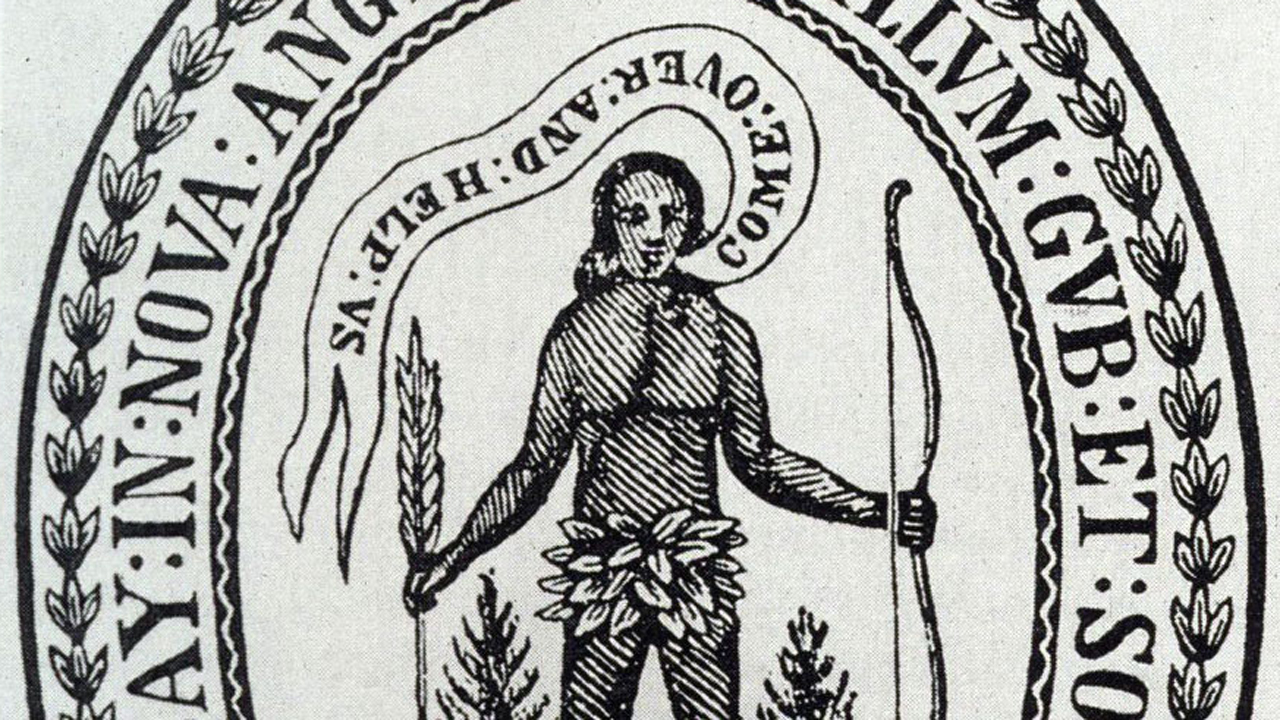J
James Glackin
Jillian Holbrook
AP US History 🇺🇸
454 resourcesSee Units
New England Colonies

Seal of the Massachusetts Bay Colony. The History Project (UC Davis)
New England was settled by disgruntled Puritans from Europe who disliked the Church of England. The Pilgrim Separatists, who were extreme Puritans, used the Mayflower to land in Plymouth Bay in 1620. They later merged their tiny Plymouth Colony with the larger Massachusetts Bay Colony in 1691.
The Massachusetts Bay Colony was chartered in 1629 and settled by about eleven thousand Puritans under the guidance of Governor John Winthrop. Winthrop declared that “we shall be as a city upon a hill,” in which the Puritans of the Bay Colony would build a model religious community based on Puritan beliefs and values. These Puritan beliefs were based on the idea that people were predestined for heaven or hell and that only male church members could vote.
Politically, New England valued the democratic town meeting. Economically, the Puritans were into shipbuilding, fishing, whaling, lumbering, and iron-making. They came to America in large families and enjoyed a lengthy lifespan, despite the cold winters.
Other colonies within New England included Connecticut, Rhode Island, Maine, and New Hampshire. Rhode Island was settled by Roger Williams, who was banned from the Bay Colony because of his religious views. Williams’ emphasis on religious diversity and tolerance would be trademarks of Rhode Island.
Similarly, Anne Hutchinson questioned Puritan authorities. She believed in the idea that faith alone, not deeds, was necessary for salvation. She and her followers were banished and founded the colony of Portsmouth, which would later be incorporated into Rhode Island.
Another group that broke off from the Puritans founded the colony of Connecticut. They drew up the Fundamental Orders of Connecticut, which became the first written constitution in American history.
🎥Watch: AP US History - Compare and Contrast Colonial America
Middle Colonies
The Middle Colonies of New York, Pennsylvania, New Jersey, and Delaware all had good farmland and produced grains for bread, ships, lumber, and furs. These colonies came to be referred to as the breadbasket colonies. However, Philadelphia and New York City also served as two major port cities.
New York was initially settled by the Dutch in 1623 after English explorer Henry Hudson sailed up the Hudson River and claimed New Amsterdam (New York City) for the Dutch. Yet England assumed control of the region in 1664.
William Penn, a Quaker, founded Pennsylvania in 1681 in what was known as "Penn's Holy Experiment." The Quakers were a peaceful religious group of dissenters from England. They believed in taking no oaths, refused military service, and were accepting of the Native Americans. Consequently, Pennsylvania became a liberal colony that was also ethnically diverse and accepting of most religions.
Chesapeake Colonies
Jamestown, Virginia, was the first English settlement in the colonies in 1607. The initial Jamestown settlers and many other Chesapeake residents died at an early age from disease. Life expectancy was much shorter than in the clean air of New England. Chesapeake families were not common due to the disproportionate number of men who immigrated to this area to make money. However, tobacco production required a massive number of white indentured servants from Europe.
Tobacco was king in both Maryland and Virginia. Maryland was founded by Lord Baltimore in 1634. His motives for settling Maryland were money and finding a peaceful haven for Catholics who were being persecuted in England. Tensions between Catholics and Protestants in this tobacco colony caused the passage of the Act of Toleration in 1649, which promised toleration to all Christians but not other religions.
Southern Colonies
In 1712, North and South Carolina separated into individual colonies. Georgia obtained its own charter in 1732. Long growing seasons in the south led to the development of plantation economies based on the export of stable cash crops. These agricultural institutions depended on the labor of enslaved Africans, which made up the majority of the southern colonial population.
England wanted South Carolina to provide food to its wealthy sugar islands in the West Indies. Rice became the main export, as slaves worked long hours in the isolated, swampy rice fields of South Carolina for this crop.
A large number of migrants from aristocratic Virginia settled North Carolina. Many of these early settlers did not like Virginia and the Church of England. As a result, the Carolinians became religious and political dissenters from Virginian authority and developed a sense of rugged individualism and democracy while being small tobacco farmers.
Georgia emerged as the last colony of the original thirteen colonies. England wanted it to serve as a defensive buffer against Spanish Florida and French Louisiana. Philanthropists, such as leader James Oglethorpe, helped those in debt and made progress in reforming debtor prisons.
Browse Study Guides By Unit
🌽Unit 1 – Interactions North America, 1491-1607
🦃Unit 2 – Colonial Society, 1607-1754
🔫Unit 3 – Conflict & American Independence, 1754-1800
🐎Unit 4 – American Expansion, 1800-1848
💣Unit 5 – Civil War & Reconstruction, 1848-1877
🚂Unit 6 – Industrialization & the Gilded Age, 1865-1898
🌎Unit 7 – Conflict in the Early 20th Century, 1890-1945
🥶Unit 8 – The Postwar Period & Cold War, 1945-1980
📲Unit 9 – Entering Into the 21st Century, 1980-Present
📚Study Tools
🤔Exam Skills
👉🏼Subject Guides
📚AMSCO Notes

Fiveable
Resources
© 2025 Fiveable Inc. All rights reserved.